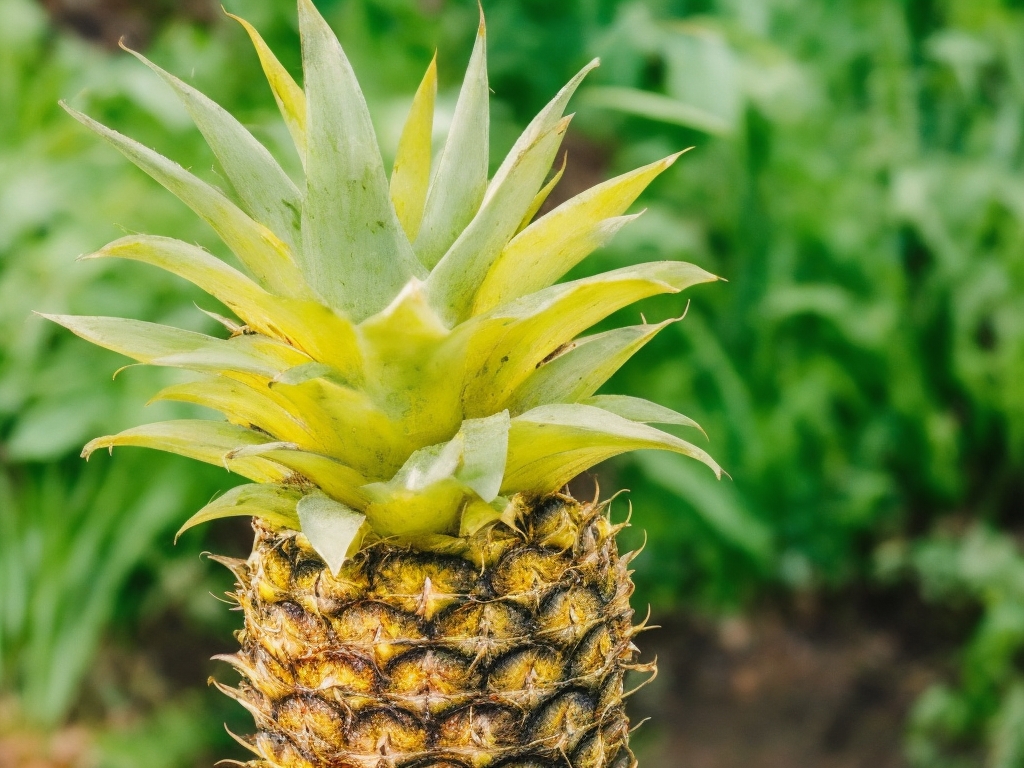In this article, you will learn about the English name for the delicious tropical fruit we all know as the pineapple. You may question why it is called pineapple in English instead of its original name, ananas. Well, let’s find out the interesting story behind this unique name.
The English name “pineapple” actually originated from the similarity between the appearance of this tropical fruit and a pinecone. The fruit, when first encountered by European explorers in the 16th century, reminded them of pinecones, leading to its name “pineapple.” So, next time you enjoy this juicy and sweet fruit, you can impress your friends with this trivia about its English name!

Definition of Pineapple
The origin of the English word ‘pineapple’
The English word ‘pineapple’ refers to a tropical fruit with a sweet and tangy flavor. This fruit stands out with its unique appearance, featuring a rough outer skin and a crown of spiky leaves. This fruit, scientifically known as Ananas comosus, belongs to the bromeliad family.
The meaning of ‘pineapple’ in English
In English, the fruit known as ‘pineapple‘ derives its name from combining two words: ‘pine‘ and ‘apple.’ The term ‘pine’ originates from the Old English word ‘pin,’ meaning ‘to prick or pierce,’ reflecting the spiky appearance of the fruit. The fruit earns the name ‘apple’ due to its round shape and the widespread popularity of apples in English-speaking countries.
Distinguishing ‘pineapple’ from ‘ananas’
It is important to note the distinction between the English word ‘pineapple‘ and the term ‘ananas’ used in many other languages. Both terms describe the identical fruit, but people use them interchangeably across various regions and languages. English-speaking countries primarily use the word ‘pineapple,’ while other languages like Spanish and French commonly use ‘ananas.’
Etymology of the Word Pineapple
Ancient origins of the word ‘pineapple’
The term ‘pineapple’ has ancient roots originating from the Tupi-Guarani language spoken by indigenous people in South America. The Tupi word for the fruit was ‘naná,’ which later evolved into ‘ananas’ in various European languages. The Tupi-Guarani people were pioneers in cultivating and consuming pineapples, predating the introduction of the fruit to Europe.
Historical references to ‘pineapple’
The first recorded mention of the word ‘pineapple’ in English dates back to the late 17th century. European explorers brought the fruit from tropical regions and used it to describe the fruit. The word gained popularity as pineapples became more widely known and sought after in Europe.
Evolution and development of the term
The term ‘pineapple’ underwent several changes and adaptations throughout history due to the influence of different languages. As the fruit became more popular and its cultivation spread, people in different regions started referring to it using their own languages. The term ‘ananas’ gained popularity in many European languages, while ‘pineapple’ remained the dominant term in English-speaking countries.
The Journey of Ananas to Pineapple
Introduction of ananas to Europe
Christopher Columbus introduced Ananas, now commonly known as pineapple, to Europe during his second voyage to the Americas in the late 15th century. Columbus encountered the fruit in the Caribbean, specifically in present-day Guadeloupe. He brought back samples to Europe, where they quickly fascinated and captivated the taste buds of Europeans.
Translation and adaptation of ‘ananas’
As ananas reached Europe, it derived the term ‘ananas‘ from its indigenous names in South America. The Spanish language, for instance, adopted the term ‘ananas,’ which remains widely used in Latin America and Spain to this day. Other European languages, including French and Italian, also adopted variations of the word ‘ananas.’
Popularization of the term ‘pineapple’
Explorers and traders popularized the term ‘pineapple‘ in English-speaking countries as they brought the fruit back from their voyages to tropical regions. People widely regarded pineapples as a symbol of wealth and hospitality, considering them a luxurious fruit. The term ‘pineapple‘ captured the imagination of English speakers, and it soon became the widely accepted name for the fruit in the English language.
Cultural Significance of Pineapple
Symbolism and cultural associations
Throughout history, people have attributed diverse symbolic meanings to pineapples, associating them with hospitality, friendship, and warmth in numerous cultures. The fruit’s distinct appearance and delightful flavor have led to its adoration as a welcoming symbol, often adorning homes, hotels, and restaurants to signify hospitality.
Pineapple in art, literature, and popular culture
The pineapple’s cultural significance is also reflected in various forms of art, literature, and popular culture. Painters and artists have depicted pineapples in still-life paintings and decorative art. In literature, pineapple has been mentioned in works of fiction and non-fiction as a symbol of exoticism and luxury. In popular culture, pineapple has been featured in movies, songs, and even as a motif in fashion and design.
Pineapple as a culinary icon
Pineapple has become an iconic fruit in culinary circles. Its unique sweet and tangy flavor makes it a popular ingredient in a wide range of dishes, from desserts to savory meals. Pineapple is used in various cuisines around the world, from tropical fruit salads to Hawaiian pizzas. It is also a key ingredient in refreshing beverages, such as piña coladas and tropical smoothies.
Varieties and Characteristics of Pineapple
Different types and cultivars of pineapple
There are several different types and cultivars of pineapple, each with its own distinctive characteristics. The most common variety is the Smooth Cayenne, known for its large size, golden-yellow flesh, and high sugar content. Other popular varieties include the Queen, Red Spanish, and MD2, each with its own unique flavor profile and appearance.
Physical appearance and features
Pineapples are recognizable by their rough, spiky skin and cylindrical shape. The outer skin, which is often golden-yellow or greenish-brown, is covered in hexagonal-shaped scales or eyes. Inside, the fruit is composed of juicy, fibrous pulp that ranges in color from pale yellow to orange-red. At the top of the fruit, there is a crown of tough, pointed leaves.
Taste and aroma profiles
Pineapples have a sweet and tangy flavor with hints of citrus and tropical fruit. The fruit’s high sugar content provides a pleasant sweetness, while its acidity adds a refreshing tang. The aroma of a ripe pineapple is fragrant and tropical, often described as a combination of pineapple, citrus, and floral notes.
Cultivation and Harvesting of Pineapple
Suitable climate and growing regions
Pineapple cultivation requires a tropical or subtropical climate with warm temperatures and high humidity. The fruit thrives in regions such as Hawaii, the Philippines, Thailand, and Costa Rica, where the climate provides optimal growing conditions. The soil should be well-draining and rich in organic matter.
Methods of pineapple cultivation
Pineapples are typically grown from the crowns or slips of mature plants. The crowns or slips are planted in the soil, and within a few weeks, roots and new leaves begin to develop. Pineapple plants require sufficient sunlight, regular watering, and periodic fertilization to ensure healthy growth. They are also cultivated using sustainable farming practices to minimize environmental impact.
Harvesting techniques and timing
Pineapples are harvested when they reach maturity, which can take anywhere from six months to a year, depending on the variety and growing conditions. The fruit is picked by hand, ensuring that only ripe pineapples are harvested. The harvesting process involves cutting the fruit from the plant, leaving a short stem attached.

Nutritional Value and Health Benefits
Overview of pineapple’s nutritional components
Pineapples are a nutritious fruit that provides various essential vitamins and minerals. They are a good source of vitamin C, manganese, and vitamin B6. Pineapples also contain dietary fiber and bromelain, an enzyme known for its anti-inflammatory and digestive properties.
Potential health benefits of consuming pineapples
Consuming pineapples as part of a balanced diet can offer several potential health benefits. The vitamin C content in pineapples supports a healthy immune system, while the bromelain enzyme can aid digestion and reduce inflammation. Pineapples also contain antioxidants that may help protect against cellular damage.
Role of pineapple in a balanced diet
Pineapples can be a refreshing addition to a balanced diet, providing natural sweetness and a range of essential nutrients. They can be enjoyed as a standalone snack, added to fruit salads, used as a topping for yogurt or ice cream, or incorporated into both sweet and savory recipes.
Versatility in Culinary Applications
Pineapple as a versatile ingredient
Pineapple’s unique flavor and texture make it a versatile ingredient in various culinary applications. It can be used in both sweet and savory dishes, adding a tropical twist and balancing flavors. Pineapple is often used in desserts, such as cakes, tarts, and sorbets. In savory dishes, it pairs well with meats, seafood, and curries.
Popular culinary uses and recipes
Pineapple is a popular ingredient in many well-known recipes. One classic example is the Hawaiian pizza, which combines ham, pineapple, and cheese on a pizza base. Pineapple is also commonly used in tropical fruit salads, in stir-fries, and as a key ingredient in fruit-based salsas and chutneys. Its juice is a common ingredient in cocktails and tropical beverages.
Pairing pineapple with other flavors
Pineapple’s sweet and tangy flavor pairs well with various other ingredients. It complements the richness of coconut, the spiciness of chili peppers, and the savory notes of meats and seafood. Pineapple can also be combined with citrus fruits, such as oranges or lemons, to create refreshing and zesty flavor profiles.

Pineapple in Traditional Medicine
Historical use of pineapple in traditional medicine
Pineapple has a long history of use in traditional medicine. Across different cultures, people have utilized the fruit along with its components like juice and bromelain enzyme for treating a wide range of ailments. People commonly used pineapple as a digestive aid, believing in its ability to alleviate pain and reduce swelling due to its anti-inflammatory properties.
Medicinal properties and applications
The bromelain enzyme found in pineapple has been the subject of numerous studies and is known for its potential health benefits. It is believed to aid digestion, reduce inflammation, and promote wound healing. Pineapple’s vitamin C content also contributes to its antioxidant properties and immune-boosting benefits.
Modern scientific research and findings
In recent years, scientific research has provided evidence supporting some of the traditional medicinal uses of pineapple (Ananas in english). Studies have shown that bromelain may help reduce inflammation associated with conditions such as osteoarthritis and sports injuries. There is also ongoing research exploring the potential anti-cancer properties of bromelain.
Conclusion
Reflection on the significance of ‘pineapple’
The English name ‘pineapple’ for the tropical fruit known botanically as Ananas comosus holds cultural, historical, and culinary significance. It has become an iconic fruit in many parts of the world, representing warmth, hospitality, and tropical allure. The linguistic journey from ‘ananas’ to ‘pineapple’ showcases the diversity and interconnections of different languages and cultures.
Summary of key points discussed
In this article, we explored the definition of pineapple, examining its origin and distinguishing it from the term ‘ananas.’ We delved into the etymology of the word ‘pineapple’ and its historical references, tracing the journey of pineapple from ananas to its popularization in English-speaking countries. We also discussed the cultural significance of pineapple, its varieties and characteristics, cultivation and harvesting methods, nutritional value and health benefits, culinary applications, traditional medicinal use, and modern scientific research.
Final thoughts on the English name for ‘ananas’
While ‘pineapple’ remains the commonly used English name for the tropical fruit, the term ‘ananas’ is still prevalent in many other languages. The varying names for pineapple in different languages highlight the richness and diversity of our global linguistic landscape. Whether you call it pineapple or ananas, this tropical fruit continues to captivate our taste buds and add a touch of the exotic to our culinary experiences.

Hi, I’m King Phils, a Dragon Fruit enthusiast and blogger. Welcome to my website, where I share everything I know and love about this amazing fruit.